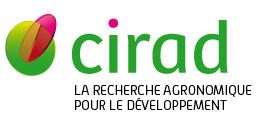Mitochondrial diversity and inheritance in Theobroma cacao L. populations
Motamayor J.C., ClÃĐment D., Caiveau O., Risterucci A.M., Lanaud C.. 2002. In : Plant, Animal and Microbe Genomes 10th Conference. Abstracts. New York : Scherago International. Plant, Animal and Microbe Genomes Conference. 10, 2002-01-12/2002-01-16, San Diego (Etats-Unis).
Within Theobroma cacao L. two morphogeographic groups have been described: Criollo and Forastero. Within Criollo, two classes have been distinguished: Ancient and Modern Criollo (corresponding to unintrogressed and introgressed individuals with Forastero genes). Restriction fragment-length poymorphism (RFLP) of mitochondrial DNA of individuals belonging to the Theobroma cacao L. groups were analyzed to provide insights into the mitochondrial DNA diversity of the species, so as to explain the basis of the mitochondrial DNA variability. Five mitochondrial types were distinguished: two within Forastero, two within Ancient Criollo, the last four and a fith one within Modern Criollo and Trinitario (hybrids between Criollo and Forastero). Mitochondrial DNA molecules bearing different atp6 and cox2 RFLP configurations were observed at stoichiometric levels in Ancient Criollo, Modern Criollo and Trinitario. A QTL analysis was performed to study the possible influence of nuclear genes on the control of the proportion of these molecules. One QTL and another putative one were found at the origin of the differences observed between individuals of a same progeny regarding the intensities of the bands obtained after hybridization with a cox2 probe. Other factors at the origin of the mitochondrial diversity observed were the transmission of male mitochondria, and possible recombination between female and male inherited mitochondrial genomes. (Texte intÃĐgral)
Mots-clÃĐs : theobroma cacao; variation gÃĐnÃĐtique; mitochondrie; rflp; gÃĐnÃĐtique mitochondriale; qtl
Communication de congrÃĻs
